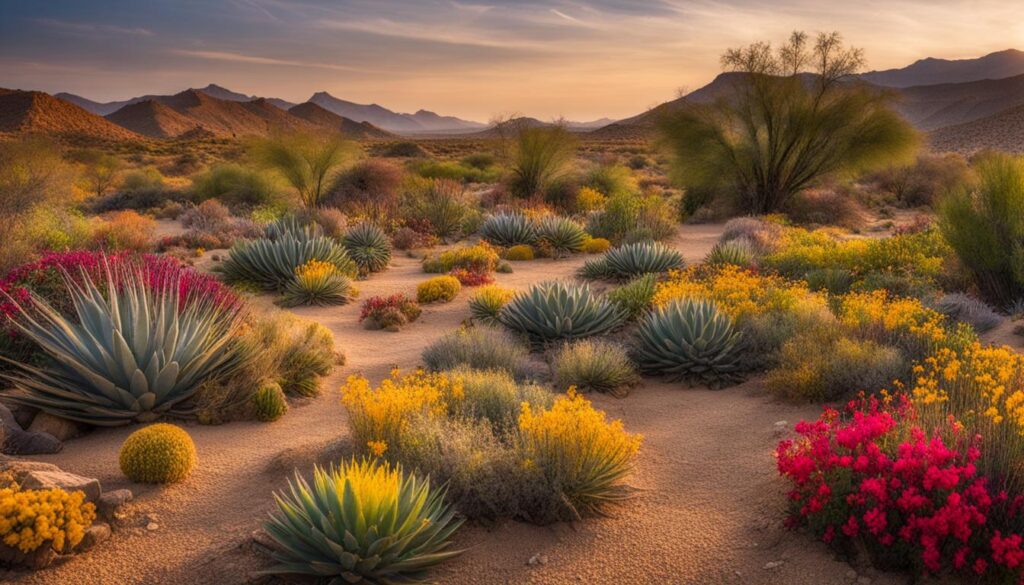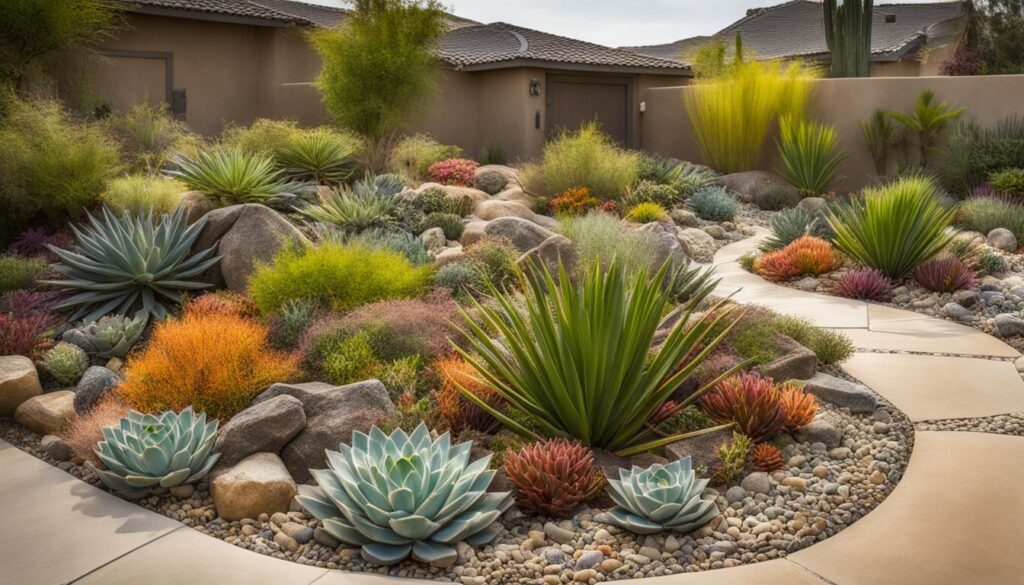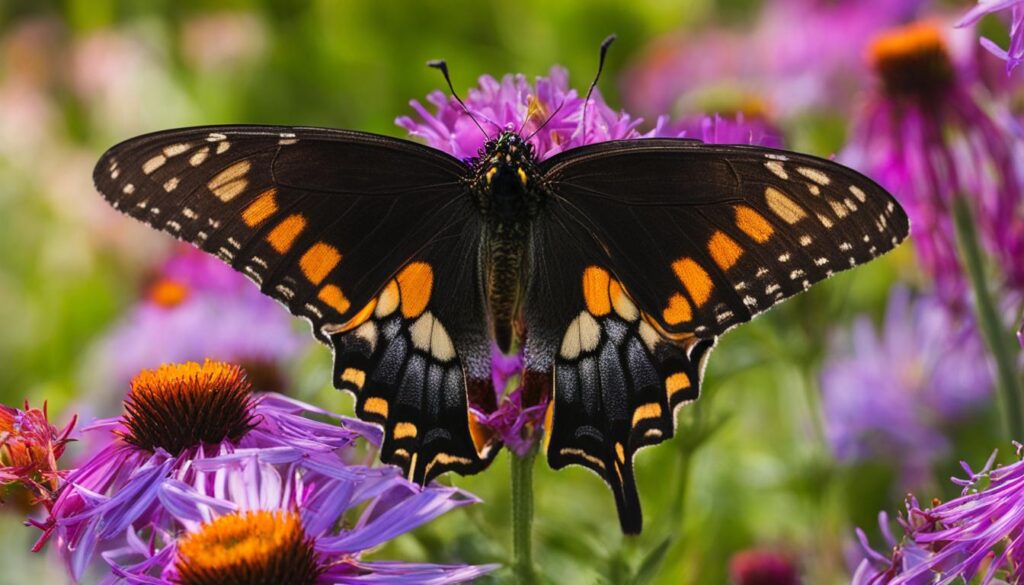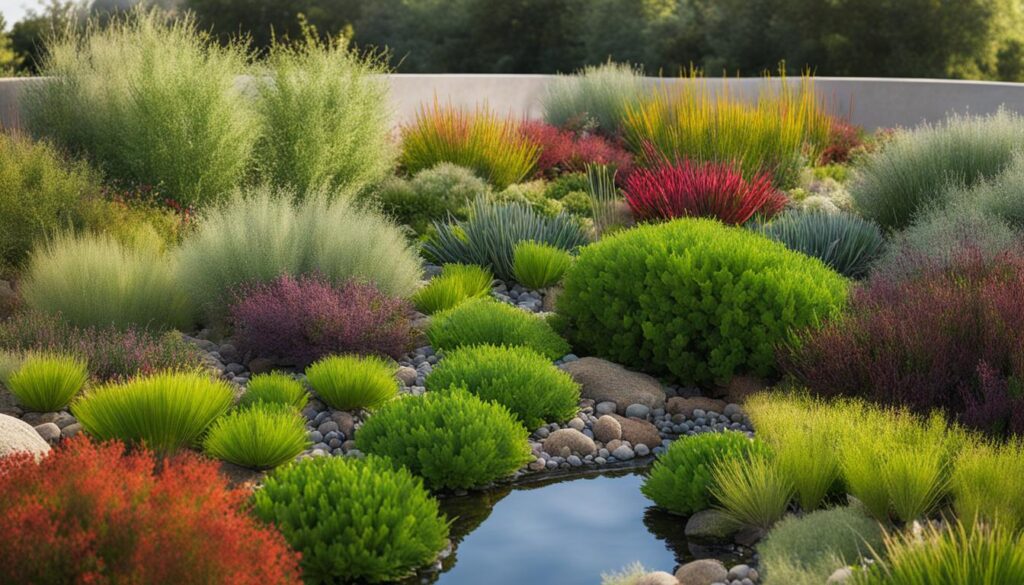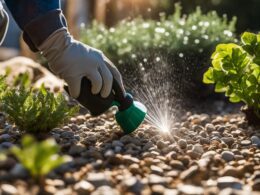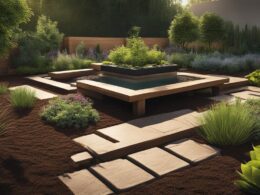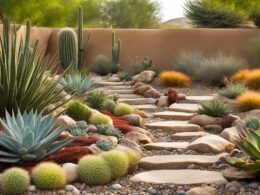Xeriscaping is a landscaping technique that aims to minimize water usage while maintaining an aesthetically pleasing and eco-friendly landscape. It involves choosing drought-tolerant plants, replacing grass with soil, rocks, and mulch, and implementing efficient irrigation methods. Xeriscaping has gained popularity in dry regions of the western United States due to its environmental and financial benefits. It can reduce water use by up to 75%, saving both water and money. Additionally, xeriscaping promotes biodiversity, saves time and energy, and reduces chemical needs.
Key Takeaways:
- Xeriscaping helps minimize water usage and promotes water conservation.
- Choosing drought-tolerant plants and efficient irrigation methods can significantly reduce water bills.
- Xeriscaping supports biodiversity and reduces the need for chemical treatments.
- Installing a xeriscaped landscape can increase the value of a property.
- By using native plants, xeriscaping creates visually appealing and diverse landscapes.
The Environmental Importance of Xeriscaping
Xeriscaping plays a crucial role in reducing water consumption and conserving water resources. By choosing drought-tolerant plants and implementing efficient irrigation methods, xeriscaping minimizes overwatering and underwatering, helping to alleviate water shortages in regions facing water scarcity. This method of sustainable landscaping ensures that more water is available for drinking and other essential needs. Furthermore, xeriscaping reduces the need for chemical treatments, as native plants are adapted to the local soil type and weather patterns, reducing the use of fertilizers and pesticides.
Native plants used in xeriscaped landscapes require less water than traditional lawns and can survive with little to no additional irrigation. By grouping these plants based on their water requirements, xeriscaping minimizes water waste and promotes efficient water usage. This not only benefits the environment by conserving water resources but also helps to reduce the strain on water infrastructure such as reservoirs, water treatment plants, and aquifers. By adopting xeriscaping practices, you can contribute to water conservation efforts and help create a more sustainable future.
“Xeriscaping minimizes water waste and promotes efficient water usage, benefiting both the environment and water infrastructure.” – Environmental Expert
Additionally, by reducing the need for regular mowing and fertilizing, xeriscaping can result in significant cost savings for homeowners. Lower water bills, decreased maintenance costs, and potential rebates or incentives offered by local governments make xeriscaping a cost-effective choice in the long run. Moreover, as more people recognize the environmental benefits of xeriscaping, properties with xeriscaped landscapes tend to have higher values. The visually appealing and low-maintenance nature of xeriscaping enhances the curb appeal of a property, attracting environmentally conscious buyers and increasing its overall value.
Financial Benefits of Xeriscaping
Implementing xeriscaping techniques in your landscape can result in significant financial savings. By reducing water consumption, xeriscaping can lead to a noticeable decrease in your water bill. In fact, studies have shown that xeriscaping can lower water usage by up to 75%, resulting in potential savings of up to 80% on water bills. This can translate into substantial cost savings over time.
Furthermore, xeriscaping eliminates the need for regular mowing, fertilizing, and other maintenance tasks associated with traditional lawns. By opting for low-maintenance native plants, you can reduce yearly maintenance costs by as much as 87%. Not only does this save you time and effort, but it also reduces the need for expensive lawn care equipment and services.
While the initial investment in xeriscaping may be higher compared to traditional landscaping methods, the long-term financial benefits far outweigh the upfront costs. Additionally, many local governments and water utilities offer rebates and incentives for homeowners who choose to xeriscape. These financial incentives further enhance the economic advantages of xeriscaping, making it a cost-effective choice in the long run.
Xeriscaping and Property Value
Xeriscaping offers not only environmental and financial benefits but also has a positive impact on the value of your property. Studies have shown that xeriscaped landscapes can increase property values by as much as 14%. By embracing xeriscaping, you can enhance the curb appeal of your home, attracting environmentally conscious buyers who appreciate the value of water conservation and the use of native plants.
A well-designed and maintained xeriscaped yard creates a visually appealing landscape that stands out from traditional lawns. The use of drought-tolerant plants and creative elements like rocks and mulch can transform your outdoor space into a unique and beautiful oasis. When potential buyers see the low-maintenance and eco-friendly features of your xeriscaped yard, they will be more inclined to appreciate its value.
By investing in xeriscaping, you are not only creating a sustainable and attractive landscape for yourself but also increasing the overall value of your property. The beauty, curb appeal, and environmental benefits of xeriscaping make it a worthwhile investment that pays off both aesthetically and financially.
Enhancing Curb Appeal with Xeriscaping
Incorporating xeriscaping into your outdoor space can significantly enhance the curb appeal of your property. The diverse colors, textures, and shapes of native plants used in xeriscaped landscapes create an eye-catching and visually appealing front yard. A well-maintained xeriscaped yard can make a strong first impression on potential buyers, setting your property apart from others in the neighborhood.
“Xeriscaping is a sustainable and eco-friendly landscaping choice that not only beautifies your property but also increases its value.”
Furthermore, xeriscaping allows for creative use of elements like rocks, mulch, and hardscape features. These additional design elements can add depth and character to your outdoor space. By strategically placing these features, you can create focal points and guide the eye to specific areas, further enhancing the overall curb appeal of your property.
Xeriscaping: The Beauty of Native Plants and Diverse Landscapes
Xeriscaping embraces the beauty of native plants and offers an array of stunning and diverse landscapes. By incorporating drought-tolerant species and native plants into your xeriscaped yard, you can create an aesthetically pleasing outdoor space while minimizing water consumption. The vibrant colors, textures, and shapes of these plants add visual appeal to your landscape, making it a true oasis.
Native plants are not only beautiful, but they also attract pollinators such as butterflies and bees. This enhances the biodiversity of your yard and promotes a balanced ecosystem. The sight of colorful butterflies fluttering among the native flowers is a delightful experience that adds both charm and environmental value to your xeriscaped garden.
In addition to native plants, xeriscaping allows for creative use of elements like rocks, mulch, and hardscape features. These elements can be strategically placed to enhance the visual appeal of your outdoor space. The texture and contrast they bring can transform a plain yard into a captivating landscape that reflects your personal style. With careful design and implementation, your xeriscaped yard can be a unique and inviting sanctuary.
With the beauty of native plants and diverse landscapes, xeriscaping offers a visually pleasing alternative to traditional landscaping. By embracing xeriscaping principles, you can create a sustainable and eco-friendly outdoor space that not only enhances your property but also contributes to the preservation of the environment. Embrace the natural beauty of xeriscaping and enjoy the benefits it brings.
Xeriscaping and Ecosystem Preservation
Xeriscaping plays a vital role in ecosystem preservation by promoting biodiversity and providing a habitat for local wildlife. By using native plants in xeriscaped yards, you create a balanced ecosystem that supports the survival of various species. Native plants attract birds, butterflies, and bees, providing them with food and shelter. This helps in maintaining the delicate balance of the ecosystem and ensures the preservation of these valuable creatures.
Furthermore, xeriscaping minimizes the use of chemical treatments like fertilizers and pesticides. Native plants are adapted to the local soil type and weather patterns, making them more resistant to pests and diseases. This reduces the need for harmful chemical interventions, which can have detrimental effects on the environment and disrupt the natural balance of ecosystems. By embracing xeriscaping, you contribute to the overall health and well-being of the environment.
Benefits of Xeriscaping for Ecosystem Conservation:
- Promotes biodiversity by attracting birds, butterflies, and bees
- Provides food and habitat for local wildlife
- Reduces the use of chemical treatments, preserving the natural balance of ecosystems
Xeriscaping is not only about creating a beautiful and low-maintenance landscape but also about preserving and protecting the ecosystems that surround us. By incorporating native plants and minimizing chemical use, you can make a positive impact on the environment and contribute to the conservation of valuable wildlife habitats.
How Do Eco-Friendly Upkeep Practices Contribute to the Environmental Benefits of Xeriscaping?
By incorporating ecofriendly xeriscape maintenance practices, such as using drought-resistant plants and utilizing mulch to retain moisture, Xeriscaping helps conserve water and reduces the need for chemical pesticides and fertilizers. This results in a healthier, more sustainable environment with less pollution and increased biodiversity.
Xeriscaping for Water Infrastructure and Energy Conservation
Xeriscaping not only offers environmental benefits, but it also plays a vital role in preserving water infrastructure and conserving energy. By reducing water demand, xeriscaping helps extend the lifespan of water resources infrastructure, such as reservoirs, treatment plants, and aquifers. This reduction in water consumption alleviates the strain on these systems, minimizing the need for costly repairs and restructuring. Implementing xeriscaping techniques can contribute to long-term sustainability and ensure the availability of water resources for future generations.
Furthermore, xeriscaping contributes to energy conservation by minimizing the energy required for various activities. Traditional lawn maintenance, such as mowing, consumes a significant amount of energy. By replacing traditional lawns with xeriscaped landscapes, homeowners can reduce the need for regular mowing and, consequently, decrease energy consumption. Additionally, xeriscaping eliminates the need for the manufacturing and application of fertilizers, further reducing energy usage and pollution. By adopting xeriscaping practices, individuals can actively contribute to reducing their carbon footprint and promoting a more sustainable future.
Minimizing Environmental Impact
Xeriscaping also plays a vital role in reducing pollution. Traditional landscaping practices often involve the use of chemical treatments, including fertilizers and pesticides, which can harm the environment. By utilizing native plants that are adapted to local soil and weather conditions, xeriscaping reduces the need for chemical treatments. This results in a significant reduction in chemical runoff and pollution, protecting local waterways and ecosystems. By implementing xeriscaping techniques, homeowners can make a positive impact on their immediate surroundings and contribute to the overall well-being of the environment.
- Xeriscaping reduces water consumption, extending the life of water infrastructure.
- Using native plants minimizes the need for chemical treatments, reducing pollution.
- Replacing traditional lawns with xeriscaping reduces energy consumption.
- By adopting xeriscaping practices, individuals can actively contribute to a more sustainable future.
Overall, xeriscaping provides a comprehensive approach to landscaping that not only enhances the visual appeal of outdoor spaces but also contributes to the preservation of water resources, reduction of energy consumption, and minimization of pollution. By embracing xeriscaping principles, individuals can create beautiful, low-maintenance landscapes that positively impact the environment and promote sustainable living.
Conclusion
Xeriscaping offers numerous benefits for the environment, homeowners, and communities as a whole. By implementing this sustainable landscaping technique, you can make a positive impact on the environment while enjoying a beautiful outdoor space. The key benefits of xeriscaping include water conservation, financial savings, biodiversity promotion, and reduced chemical use.
One of the main advantages of xeriscaping is its ability to conserve water. By choosing drought-tolerant plants and implementing efficient irrigation methods, you can significantly reduce your water consumption. This not only helps alleviate water shortages but also leads to substantial savings on your water bill. Xeriscaping also supports the preservation of local ecosystems by providing food and habitat for wildlife, thanks to the use of native plants.
Financially, xeriscaping offers long-term savings. While the upfront costs of installing a xeriscaped landscape may be higher, the reduced water bill and lower maintenance requirements can result in significant cost savings over time. Moreover, many local governments provide rebates and incentives for homeowners who choose xeriscaping, further enhancing the financial benefits.
Embracing xeriscaping means embracing sustainable landscaping practices. By reducing water consumption, minimizing chemical use, and preserving natural ecosystems, you are contributing to a more sustainable and environmentally friendly future. Transform your outdoor space into a beautiful, low-maintenance landscape that not only enhances the value of your property but also supports the health of the environment.






